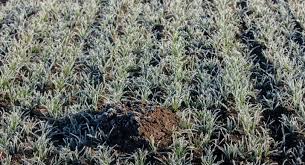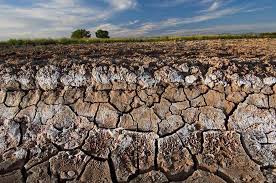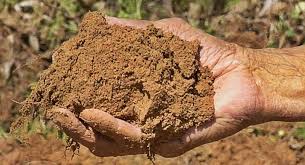Soils serve as the foundation for plants by providing essential water and nutrients for growth and development. They also act as anchors, stabilising plant structures.
Soil conditions determine the availability of nutrients and influence the type of crops suitable for cultivation.
This article discusses different soil conditions salinity, alkalinity, and acidity their effects on soil and crops, and the corrective measures needed to manage them effectively.
Read Also: Vaccination Program for Poultry Chickens
Understanding Soil Salinity in Agriculture

Salinity is a soil condition where the electrical conductivity of the soil solution reaches 4 decisiemens/m or more at 25°C, with an exchangeable sodium percentage below 15% and a pH of less than 8.5. Soils with these characteristics are known as saline soils.
These soils typically display a white salt crust on the surface, especially in the dry season when moisture movement is upward.
As water evaporates, it leaves behind these salts, which often include chlorides, sulphates, and carbonates of calcium, magnesium, and sodium.
Understanding Soil Alkalinity and Its Agricultural Implications
Alkalinity refers to soils with an electrical conductivity below 4 decisiemens/m at 25°C, an exchangeable sodium percentage above 15%, and a pH ranging from 8.5 to 10.0. Such soils are referred to as alkaline soils.
High sodium levels in these soils cause clay and organic matter to disperse, resulting in dense packing of soil particles.
This limits pore space, hindering water and air movement, and makes the soil less permeable. Poor aeration and sodium toxicity make alkaline soils difficult and costly to reclaim.
Formation of Saline and Alkaline Soils in Agricultural Lands

Saline and alkaline soils are formed under the following conditions:
i. In arid regions with low rainfall and high temperatures, soluble salts accumulate near the surface. During the rainy season, salts may move deeper but return to the surface through evaporation after the rains.
ii. Groundwater in dry regions contains significant soluble salts. When the water table is high, water moves to the surface via capillary action and evaporates, leaving salts behind.
iii. Salts may originate from chemical weathering of rocks and are dissolved by surface or percolating water.
iv. Under irrigation, several factors contribute to soil salinisation or alkalisation:
i. Excessive irrigation raising groundwater levels, leading to salt accumulation.
ii. Seepage from leaky or elevated channels causing a rise in the water table.
iii. Irrigation water containing high salt levels.
iv. Poor drainage preventing leaching of salts.
v. Inconsistent irrigation practices such as alternating flooding and drought.
Effects of Saline and Alkaline Soils on Crops and Soil Structure
Saline soils often appear barren but are potentially productive. Excess salts in the soil solution raise osmotic pressure, limiting water and nutrient absorption.
This leads to a high wilting coefficient and reduced available moisture. Sodium ions also hinder calcium and magnesium uptake.
In alkaline soils, the damage is caused by sodium rather than overall salt concentration. Sodium binding to clay and organic matter causes soil dispersion, loss of structure, reduced drainage, poor aeration, and lower microbial activity.
High pH levels also decrease the availability of micronutrients like iron, copper, manganese, and zinc.
Reclamation and Control of Saline and Alkaline Soils in Agriculture
Effective reclamation of saline and alkaline soils requires an understanding of:
- Soil quality
- Irrigation water quality
- Salt distribution in the root zone
- Subsoil water level
- Drainage condition
Technical Requirements for Reclamation
i. Adequate drainage to allow salt removal
ii. Sufficient water for crop use and salt leaching
iii. Improved soil management including land leveling, proper bunding, and sound agronomic practices
iv. Good quality irrigation water assessed for suitability
In saline soils rich in calcium and magnesium, reclamation is easier through leaching. Effective leaching typically requires about 60 cm of irrigation water. In areas with high water tables, artificial drainage is necessary before salt removal can begin.
In alkaline soils, the high sodium content makes the soil resistant to water penetration. Reclamation requires replacing sodium with another cation—calcium is commonly used for this purpose.
Gypsum (calcium sulphate) is most effective. It converts sodium salts into calcium-based compounds, improving soil pH and physical structure.
Subsequent flooding helps wash away sodium sulphate. In severe cases, sulphuric acid may be used, though this requires expert handling and is costly.
Salt-Tolerant Crops Suitable for Problematic Soils
In situations where reducing soil salt levels is not feasible, salt-tolerant crops should be planted. Among field crops, barley, sugar beet, and cotton are the most tolerant, while beans are highly sensitive.
Small grains have moderate salt tolerance. Among fruit crops, date palm shows high tolerance to salinity, whereas most other fruits are sensitive.
Understanding Soil Acidity and Its Effects on Agriculture
Soil acidity reflects a higher concentration of hydrogen ions (H⁺) compared to hydroxyl ions (OH⁻), with a pH range of 1–6.5. Hydrogen ions are mainly held by clay or organic colloids. Causes of soil acidity include:
- Heavy rainfall leading to leaching
- Parent materials that are naturally acidic
- Use of acid-forming fertilisers
- Microbial activities that increase soil acidity
Read Also: Vaccination Program for Poultry Chickens
Effects of Soil Acidity on Crop Growth and Soil Health

The impact of soil acidity on crops can be:
1. Direct Effects:
i. Toxicity from hydrogen ions damaging root tissues
ii. Altered permeability of plant membranes to cations
iii. Imbalance between basic and acidic ions in plant roots
iv. Disruption of enzyme functions, which are sensitive to pH changes
2. Indirect Effects
i. Reduced availability of nutrients like phosphorus, copper, and zinc
ii. Toxic levels of soluble aluminium, manganese, and iron
iii. Reduced activity of beneficial soil microorganisms
iv. Increased susceptibility to plant diseases
v. Deficiencies of essential nutrients like calcium and potassium
Certain crops such as rice, oats, and linseed can tolerate moderately acidic soils with a pH around 5.0.
Correction and Management of Soil Acidity in Farmlands
Soil acidity is corrected through the use of lime materials. When lime is added to moist soil, calcium ions replace hydrogen ions in the exchange complex, thus neutralising acidity. Lime materials include:
- Ground limestone (calcic limestone – CaCO₃)
- Dolomitic limestone
- Quicklime (CaO)
- Hydrated lime (Ca(OH)₂)
- Coral shell lime
- Chalk
- Gypsum
It is advisable to avoid acid-forming fertilisers like ammonium sulphate and ammonium nitrate when managing acidic soils.
Soil condition plays a critical role in crop growth and productivity. Farmers must assess soil properties to select crops that match the soil’s condition.
In acidic soils, acid-tolerant crops should be cultivated. Similarly, in saline or alkaline environments, choosing appropriate management practices or salt-tolerant crops is key to sustaining agricultural productivity.
Do you have any questions, suggestions, or contributions? If so, please feel free to use the comment box below to share your thoughts. We also encourage you to kindly share this information with others who might benefit from it. Since we can’t reach everyone at once, we truly appreciate your help in spreading the word. Thank you so much for your support and for sharing!
Frequently Asked Questions
We will update this section soon.

